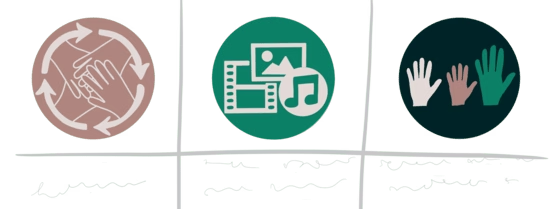TeachEUR
Support
Translating UDL to Practice
Universal Design for Learning (UDL) is an educational framework aimed at creating inclusive learning environments that can accommodate all students. UDL promotes the idea that curricula should be flexible and adaptable to meet the diverse needs of learners. It focuses on providing multiple pathways for students to engage with content, represent their knowledge, and express their learning. The framework is based on three core principles: multiple means of engagement, representation, and action and expression. These principles emphasize that learners have unique strengths and challenges, and the goal of UDL is to create a learning environment that supports all students, regardless of their abilities or backgrounds, by offering varied ways to access, understand, and demonstrate knowledge.
Engagement
Get to know your students: Understand students' interests, backgrounds, and motivations to tailor learning activities that resonate with them.
Provide examples relatable to their realities or/and collect examples from them: Include real-world connections or cultural references to enhance motivation and engagement.
Provide applicability of content beyond academia: Show how learning relates to everyday life or future careers, making it relevant and motivating.
Focus on collaborative learning: Encourage group work and peer interactions to build a supportive learning community where students share diverse perspectives.
Representation
Provide the overall goal beforehand: Clearly articulate the learning objectives so students understand the purpose of the lesson or task.
Written and verbal instructions are always provided: Offer instructions in both formats to accommodate different learning preferences.
Provide extra material when possible (e.g., YouTube videos, podcasts, handouts): Offer supplementary resources to help students engage with the content in various ways.
Highlight key points when writing (italics, bold, underlined): Use text formatting to emphasize important concepts and make them stand out.
Use plain language: Avoid jargon and overly complex language, making content accessible to a wider range of learners.
Use summaries in layman’s terms: Provide simplified summaries of complex ideas to ensure understanding across various learning levels.
Expression
Provide clear and straightforward instructions both in oral and written format (templates): Ensure students understand how to approach assignments by offering templates and step-by-step guides.
Provide complete rubrics: Share detailed rubrics for assignments so students understand the expectations and grading criteria.
Use sample/mock assignments: Provide examples of completed tasks to clarify expectations and offer guidance.
Give preference to interactive and/or task-based formats: Encourage hands-on, task-based learning that allows students to engage with content actively.
Allow students to combine components of their interest with course content whenever possible: Offer opportunities for students to personalize assignments by connecting them with their interests and passions.
This approach to translating UDL into practice ensures that all students, regardless of their neurodivergency or backgrounds, can thrive in an inclusive, engaging, and supportive educational environment.
For more information, please visit the UDL website: https://udlguidelines.cast.org

